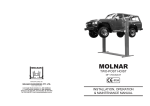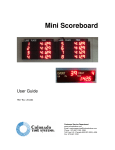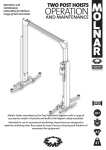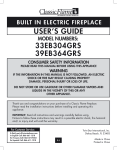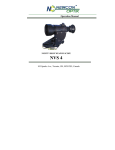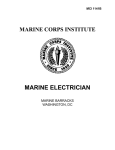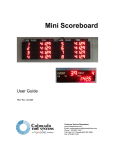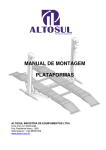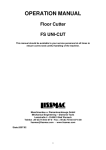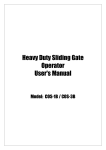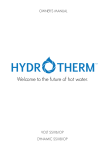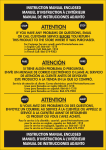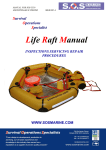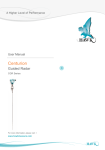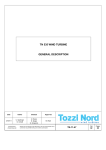Download Four Post Hoists User Manual
Transcript
Molnar Engineering Pty. Ltd Installation Operation Maintenance Instructions MOLNAR Four Post Hoist Models: 3585 & 4488 OPTIONAL 240 VOLT SINGLE PHASE MINIMUM REQUIREMENTS FOR ELECTRICAL CONNECTION OF MOLNAR HOISTS Important: All installations should be carried out by suitably qualified persons. Failure to comply may void warranty. The following information is a guide only based on the latest standards as set out in AS/NZS 3000, for installations outside of Australia & New Zealand refer to local standards/regulations. Circuit Breakers should be of “D” curve type (motor start, high inrush current) - Ratings given as a maximum for circuit & motor protection based on DOL selection guide. Voltage operating range: -6% to +10% of motor nameplate Voltage. Motor Voltage 240V Operation range 225V to 264V. Cable sizes are given as a guide only for a maximum cable length to 30m. Longest cable runs and in area where supply voltage is below motor voltage, calculation should be made to ensure Voltage Drop will not fall below minimum operating voltage. When installed motors must be tested under Full Load checking Voltage at motor terminals. Motor 2.2kW 240V Single phase model CWC3640F Full Load Current Min Cable Size Circuit Breaker 12.4 Amps 2.5mm 2 core + earth 1 phase 32 Amp 10kA Recommended Clipsal 4CB132/10 or equivalent No person should be permitted to operate the MOLNAR FOUR-POST HOIST without first studying the operating instructions on page 5 and safety precautions on page 4. This manual should be kept in a safe place and referred to as necessary. The installation requirements on page 24 must be completed and the certificate on the inside back cover must be signed by the installer. The guarantee card must be completed and returned to MOLNAR ENGINEERING PTY. LTD. In tropical and steam cleaning conditions to prevent rust in the cylinder raise the hoist to full height and leave it there when not in use overnight and on weekends. This vehicle hoist is not designed to be used for steam cleaning nor to be installed in the open exposed to the elements. Vehicle hoists installed under such conditions are not covered by our guarantee. Page 1 OPTIONS MOLNAR JB 87 Molnar Jacking Beam OPTIONAL EXT PAD Suitable for Molnar Jacking Beam Specifications SPECIFICATIONS Capacity 2000 kg Minimum Height 75 mm Lifting Travel 280 mm Maximum 1250 mm saddle spacing Net Weight 78 kg Fittings 2 Support Pads 2 Saddles As industry leaders in the manufacture of 2 and 4 post vehicle hoists, Molnar Engineering Pty Ltd have applied this same knowledge to the JB 87 Hydraulic Jacking Beam. The unit is for use in conjunction with a ramp 4 post hoist and has been specially designed to provide versatility and ease-of-operation for a wheel free system. FEATURES • Low profile in the parked position. • Vertical travel of pumping handle provides for ease of vehicle lifting. • Support pads and adjustable slide arms and saddles provide for all types of vehicles and lifting operations. • Body end rollers allow for non-jamming travel along ramps. • Large knurled handle permits easy gripping for valve control. Page 2 CONTENTS Page No. Options . . . . . . . . . . . . . . . . . . . . . . . . . . . . . . . . . . . . . . . . . . . . . . . . . . . . . . . . . . . . . . 2 Foreward . . . . . . . . . . . . . . . . . . . . . . . . . . . . . . . . . . . . . . . . . . . . . . . . . . . . . . . . . . . . . 4 Safety Precautions . . . . . . . . . . . . . . . . . . . . . . . . . . . . . . . . . . . . . . . . . . . . . . . . . . . . . 4 Operating Instructions . . . . . . . . . . . . . . . . . . . . . . . . . . . . . . . . . . . . . . . . . . . . . . . . . . 5 Setting up the hoist . . . . . . . . . . . . . . . . . . . . . . . . . . . . . . . . . . . . . . . . . . . . . . . . . . . . 6 Floor Requirements . . . . . . . . . . . . . . . . . . . . . . . . . . . . . . . . . . . . . . . . . . . . . . . . . . . . 7 Installation . . . . . . . . . . . . . . . . . . . . . . . . . . . . . . . . . . . . . . . . . . . . . . . . . . . . . . . . 8 - 20 Parts Identification . . . . . . . . . . . . . . . . . . . . . . . . . . . . . . . . . . . . . . . . . . . . . . . . 12 - 13 Layout of wire ropes . . . . . . . . . . . . . . . . . . . . . . . . . . . . . . . . . . . . . . . . . . . . . . . . . . 18 Wiring Diagrams . . . . . . . . . . . . . . . . . . . . . . . . . . . . . . . . . . . . . . . . . . . . . . . . . . . . . . 19 General layout of locking mechanism . . . . . . . . . . . . . . . . . . . . . . . . . . . . . . . . . . . 20 Betabite Hydraulics Assembly Instructions . . . . . . . . . . . . . . . . . . . . . . . . . . . . . . . . 20 Replacement parts list. . . . . . . . . . . . . . . . . . . . . . . . . . . . . . . . . . . . . . . . . . . . . . . . . 21 Fault Chart . . . . . . . . . . . . . . . . . . . . . . . . . . . . . . . . . . . . . . . . . . . . . . . . . . . . . . . . . . 21 Maintenance . . . . . . . . . . . . . . . . . . . . . . . . . . . . . . . . . . . . . . . . . . . . . . . . . . . . . . . . 22 Drip Tray Inspection and Safety Instructions. . . . . . . . . . . . . . . . . . . . . . . . . . . . . . . 23 Wheels Free Rails . . . . . . . . . . . . . . . . . . . . . . . . . . . . . . . . . . . . . . . . . . . . . . . . . . . . . 24 Installation Requirements . . . . . . . . . . . . . . . . . . . . . . . . . . . . . . . . . . . . . . . . . . . . . . 24 Certification . . . . . . . . . . . . . . . . . . . . . . . . . . . . . . . . . . . . . . . . . . . . . . . . . . . . . . . . . 25 Page 3 FOREWORD SAFETY PRECAUTIONS SERVICE AND MAINTENANCE OF THE HOIST IS THE RESPONSIBILITY OF THE OWNER Page 4 OPERATING INSTRUCTIONS Page 5 SETTING UP THE CAR HOIST Page 6 FLOOR REQUIREMENTS The floor should be a reinforced concrete slab with Compressive strength of minimum 25Mpa. Reinforcement wire diameter 6mm x 200mm x 200mm square mesh F42 grade. Minimum thickness of 100mm. For a successful installation, it is important that the floor is flat and level at the points where the posts are bolted to the floor. Maximum level differences are referred to in Figure 4. FIGURE 2 When the floor slope is greater than the recommended difference (Figure 4) the four post foundation plates must be levelled by either: A LOCAL LEVELLING BY MEANS OF CONCRETE FOUNDATION BLOCKS B BY SUITABLE PACKING UNDER POST FOUNDATION PLATES Figure 4A shows the recommeded concrete foundation blocks. FIGURE 3 A drive-on angle that is too acute (as illustrated) is to be avoided, as this condition can cause damage to the underside of vehicles. Page 7 Page 8 INSTALLATION OF THE HOIST "FLOOR REQUIREMENTS" Remove nuts from the cable ends for assembly purposes and install the wire ropes in the transverse beams in the following manner. Page 9 Page 10 INSTALLATION OF HOIST (to oil level line) Page 11 Page 12 Page 13 Page 14 INSTALLATION OF HOIST 19.Press the starter button on the contact box and raise the hoist slightly. If the motor turns, but the hoist does not lift, then the motor is turning in reverse, and two phases in the contact box must be interchanged to reverse the direction of rotation (by an Electrician). 20.Raise hoist approximately 200mm and remove the blocks on which the transverse beams and platforms have been resting. Check all the hydraulic couplings to ensure the there are no oil leaks (including hydraulic cylinder coupling). NOTE: MAKE SURE THAT THE WIRE ROPES ARE NOT CROSSED AND THAT THEY DO NOT FOUL ANY PART OF THE HOIST ASSEMBLY OR THEIR LIFE WILL BE SEVERELY SHORTENED. 21.Lower the hoist to a point where the end of the transverse beam adjacent to No. 1 Post is approximately 50mm from the base plate. 22.Adjust the posts so that they are square to the transverse beams and the rollers at the ends of the beams contact the backs of the posts. Do not force the posts against the rollers. 23.For the hoist to function correctly, it is essential that the sides of both transverse beams are exactly vertical. Using a spirit level, check the transverse beams at the points indicated by the arrows in Figure 17. If the beams are out of vertical, shims (packing X11) between the platforms and transverse beams will have to be used as indicated in Figure 18. 24.When all posts are correctly positioned, secure them to the floor. 16mm x 64mm DYNABOLT are recommended for fastening down. This may differ in some states. 25.The posts must be exactly vertical in all planes and to each other for correct operation of the hoist. If they are not vertical, shims must be used under the baseplates. 26.Ensure that the locking toggles at the control ends of the transverse beams (adjacent No.1 & No. 3 Posts) are both off. Fit the long square tube, (with the load holding control handle in a near vertical position) by sliding the control end over the safety-actuating square lug on the transverse beam adjacent to No. 1 Post. Bow the tube, by pulling out at the middle of the tube and slide the other end of the tube on the safety-actuating square lug on the transverse beam adjacent to No. 3 Post. Fit the retaining bracket to the centre of the driver’s side platform. 27.Lower the hoist (using the lowering lever on the power unit) until the transverse beams rest in the centering plates at the bottom of the posts. Tension the wire ropes via the nuts in the following manner: NOTE: In order to allow for normal wire rope stretch, it is advisable to have a car on the hoist for this operation. Tension the 4 wire ropes until they are just about to lift the transverse beams. Engage the locking toggles by moving the load-holding control handle to the horizontal position. Raise the hoist, taking note of the clicking sound made by the locking toggles. If the four toggles all click together, the load holding is operating correctly. If the toggles are not synchronised, appropriate adjustments must be made. Leaving the load-holding control handle in the ON position, lower the hoist until all locking toggles are engaged, observing when the locking toggles engage in relation to No. 1 Post. Adjust the wire rope tension at one post at a time until all locking toggles engage simultaneously. The platforms should be level when all four locking toggles lock in simultaneously. When the locking toggles are operating satisfactorily, fit the lock-nuts to the wire rope ends and tighten. Page 15 Page 16 INSTALLATION OF HOIST 28.Adjust the side rollers on the transverse beams so that they just contact the sides of the posts. NOTE: This is not applicable to the “WHEEL-FREE” models. 29.Adjust the limit switch actuating bracket so that it clears the No. 1 Post by approximately 2mm. Adjust the limit switch so that the hoist automatically stops before the safety toggle rollers reach the wire rope ends. 30.Fit the run-up ramps at the drive-on end, and the wheel stops at the other end of the platforms. NOTE: “WHEEL-FREE” models only. Bolt the run-up ramp locating bar in position and fit the other section of the run-up ramps. Fit the run-up ramp extensions. Fit the two WHEEL-FREE RAILS so that they rest on the secondary transverse beams. 31.Double check that all wire ropes are properly seated on the pulleys, (refer layout of wire ropes) and that the hoist is operating correctly. Double check that the wire ropes are not crossing each other. FITTING OF JACK STAND AND JACKING BEAMS JB87 32.Fit The Jack Stand (and Jacking Beams “JB87”, (if purchased). NOTE: Remove 3 of the 4 countersunk bolts holding the secondary platform (platform adjacent to NO. 2 and No. 4 posts) in position. Slide the platform outwards, place the Jack Stand (and Jacking beams) into position. Slide the platform into the original position. Re-bolt the platform with the 3 countersunk bolts. 33.Clean the hoist of anti-corrosion spray. FITTING OF DRIP TRAY 44880DRPT 34.(1). Raise hoist to normal working height, engage safety locks and lower until hoist is just resting on the safety locks. (2). Orientate Drip Tray so the Support Tabs are on the top and slide Drip Tray over the top of the Ramp Brace Strap. Refer to Figure 21 on page 23, steps 1, 2 & 3. (3). Locate Drip Tray in the cavity created by the inside edges of the ramp, the Ramp Brace Strap and the Cylinder Support Strap. Refer to steps 4 & 5. (4). Push down on the Support Tabs to ensure the bottom of the drip tray protrudes slightly below the bottom of the Straps. Refer to step 6. It is important that the top of the Drip Tray is pushed down as low as possible for there is little clearance from the top of the Straps and the bottom of the Cable Block. The Drip Tray is in danger of being crushed by the Cable Block if the top of the Drip Tray is too high. (5).Check Drip Tray clearance by slowly lowering the hoist until Cable Block travels over the area of the Drip Tray. If the Cable Block touches the Drip Tray repeat step 4. (6). Installation is complete. Page 17 LAYOUT OF WIRE ROPES Page 18 WIRING DIAGRAMS WIRING TO THESE UNITS TO COMPLY WITH AS 3000 Page 19 GENERAL LAYOUT OF LOCKING MECHANISM BETABITE HYDRAULICS ASSEMBLY INSTRUCTIONS FIGURE 20 1. Cut the tube to length and file ends square. 2. Remove internal and external burrs from tube end. 3. We always highly recommend that joints are pre-made whilst the coupling body is held firmly in a bench vice. 4. Ascertain that all the detail parts of the coupling are suitably lubricated, especially the internal body cone, the rear of the ferrule and the internal thread of the nut. The lubrication process is recommended on all fittings, however, on stainless steel couplings the use of a quality lubricant is imperative. Betalube, a copper based paste is highly recommended and available from Betabite Hydraulics or your local distributor. Please note after assembly, fittings to be used on Oxygen lines should be fully degreased. 5. Slide the nut onto the tube, followed by the ferrule, the open end of the nut should be towards the end of the tube, and similarly, the cutting or smaller end of the ferrule should point towards the tube end. 6. Present the tube, nut and ferrule to the coupling body, making sure that tube passescleanly through the nut and ferrule & butts firmly against the step (abutment face) provided in the coupling body. Screw the nut onto the coupling body until finger tight. 7. Hold the tube in one hand and with the correct sized spanner in the other hand, tighten the nut until the ferrule is felt to just grip the tube. This point is determined by rotation or slightly rocking the tube. From this point, the nut should be tightened 1 ¼ to 1 ½ turns from the initial ring grip to obtain a fully effective cutting action. On larger sizes of fitting, an extension to the spanner is highly recommended to maximise leverage and minimise effort. 8. If the nut is now removed, the ferrule will have cut its own seating on the tube and whilst it will be found to rotate, it cannot be moved towards the tube end. The 'joint' may now be re-assembled, by re-tightening of the nut until significant resistance is felt and then increase for a further 1/8 to ¼ of a turn. The above procedure must be followed closely to ensure a safe and successful joint. 9. Betabite fittings correctly made can be broken repeatedly, when not under pressure and re-made without affecting their pressure tightness and leak-proof quality. Page 20 REPLACEMENT PARTS LIST Part No. 4488-SP-1 4488-SP-2 4488-P-3 4488-P-4 4488-P6A 4488-P-7 4488-P-8 4488-P-9 4488-P-10 4488-P-11 4488-TB-12A 4488-TB-13 4488-TB-17 4488-TB-24 4488-TB-29 4488-TB-34 4488-TB-55 4488-TB-59 4488-S/W-65 4488-S/W-66 4488-SP-18 4488-SP-80 Description Drawing Ref. No. No. 1 Post - Standard type 1 Post - Standard type 2 Safety Rail 3 Bolt 4A Shock absorber ND Cable nut 7 Cable #609 No. 1 Post 8 Cable #610 No. 2 Post 9 Cable #611 No. 3 Post 10 Cable #612 No. 4 Post 11 Transverse beam 12 Cable retaining pin 13 Nylon pulley bush (2 per pulley) 17 Pin 24 Roller 29 Pawl 34 Activating Bracket 55 Detent ball assembly 59 Wheel Stops 65 Run-up ramp 66 Single pulley assembly 18 Bush 80 Part No. 4488-DP-98 4488-DP-95 4488-R-61 4488-R-62 4488-R-K63 4488-R-67 4488-R-68 4488-R-69 4488-R-68 4488-R-69 4488-C-100 4488-C-AK107 4488-C-K110 4488-C-120 4488-PP 4488-PP-122 4488-PP-129 4488-PP-150 4488-DRPT Description Drawing Ref. No. Twin groove pulley 98 Bearing 95 Locking mechanism connecting rod 61 Locking mechanism handle 62 Locking mechanism mounting bracket 63 Left platform 67 Wheel alignment recess cover 68 Right platform 69 Wheel alignment recess cover 68 Right platform 69 Cylinder guide roller 100 Cylinder assembly 107 Cylinder seal kit 110 Hydraulic hose 120 Power Pack Assembly ND Oil Tank 122 Control Valve 129 Hydraulic pump 150 Oil Drip Tray ND NOTE: ‘ND’ denotes ‘Not Drawn’. NOTE: Model and serial number of hoist must be quoted when ordering parts FAULT CHART FAULT PROBABLE CAUSE REMEDY Leakage of oil at joints. Loose joints in the high pressure pipes. Inspect the piping and tighten joints. Leakage of oil at top of Hydraulic cylinder. Worn Hydraulic seal in hydraulic cylinder Replace Hydraulic seal or cylinder. Lack of lifting power. Problem with Hydraulic Pump Low voltage to Electric Motor Replace or Repair Hydraulic Pump Contact a Licensed Electrician Hoist fails to stay up. Internal leak in Hydraulic Valve Replace Hydraulic Valve with a new or re-conditioned Hydraulic Valve. Empty Oil. Clean tank and replace Hydraulic Oil. Hoist does not respond to Operation switch. Power supply to motor is interrupted. Motor turning in opposite direction. Check Circuit Breaker. Contact a Licensed Electricion. Damaged cable Worn sheaves and sheave pins or bushes Replace sheaves, sheave pins and cables and bushes. Load holding topggles are not engaging simultaneously or are not releasing simultaneously. Wire ropes are not correctly tensioned. Adjust wire ropes as per installion instruction on page 17. Page 21 MAINTENANCE CHECK DAILY Check safety mechanism to see that it functions properly. CHECK MONTHLY Safety mechanism operation. Condition of sheaves, shafts and shaft locks. Condition of wire ropes. Overall cleanliness. CHECK 3 MONTHLY Note: The Drip Tray should be inspected following the inspection instructions. Hydraulic oil collected in the Drip Tray could be recycled into the tank or disposed of. Filling the tray with an absorbent material as shown in Figure 22 may assist with the disposal of collected oil. FIG 22 CHECK 6 MONTHLY Oil leaks from the cylinder, pipe joints and anchor bolts Wire ropes Wire ropes must be inspected by a COMPETENT person. Inspect for wear, rust and broken wires. Wire ropes must be replaced if: At any point the visible number of broken wires exceeds 10 in any length of rope equivalent to 20 times the ropes diameter, i.e. for 13mm diameter rope 10 broken wires in 260mm of cable. A strand of wire is broken. A rope has been physically damaged by crushing or deforming. YEARLY Service and safety inspection on hoist be performed by a competent person. This inspection must be recored. If the 12 monthly service and safety inspection is not performed, the warranty is null and void. NOTE: Yearly service must include removal of pulleys to inspect and clean bushes. 2 YEARLY Hydraulic oil should be replaced (irrespective of the amount of use to which the hoist is subjected). Fill Hydraulic Tanks to oil level line with Castrol Hyspin AWH46, Shell Tellus T46, Mobil DTE 25, BP Bartran HV46 or equivalent. LUBRICATION Smear the wire ropes once per month with an acid-free grease to guard against rust formation. OIL CHANGING 1. Lower the hoist to the ground. 2. Clean out the oil tank, using approx. 7 litres of cleaning oil with parafin base. 3. Raise and lower hoist without load once. Drain flushing oil and refill with recommended hyraulic oil. TOPPING UP If hoist does not rise to maximum height and motor does not switch off automatically, it is possible that there is insufficient oil in the tank. Lower hoist and replenish with recommended Hyraulic oil. Page 22 DRIP TRAY INSPECTION & SAFETY INSTRUCTIONS 1. Using both hands to support the Drip Tray, keeping it parallel to the ground, push up untill the bottom of the Drip Tray is above the top of the Ramp Brace Strap. 2. Slide Drip Tray over the Ramp Barce Strap and lower the Drip Tray down when it is clear of obstructions ensuring that the tray always remains parallel to the ground. 3. Visually inspect the Drip Tray for oil and recycle or dispose of oil if present. 4. Clean the outside of the Drip Tray if any oil is present. 5. Relace the Drip Tray following the installation instructions. When handling and disposing of materials the correct procedures and regulations must be followed. Be familiar with the regualtions on handling and disposing of Hydraulic Oil before using the Drip Tray. This also applies if an absorbent material is used in the Drip Tray. FIG 21 STEP 1 STEP 4 STEP 2 STEP 5 STEP 3 STEP 6 Page 23 INSTALLATION REQUIREMENTS INSTALLER MUST CHECK THE FOLLOWING LIST WHEN INSTALLING A MOLNAR FOUR-POST HOIST 1. A suitable floor where the hoist is to be bolted down must have a level surface. When the hoist is bolted down check all nuts and bolts to ensure they are correctly tightened. 2. Check wire ropes and sheaves for possible transport damage or dislocation. 3. When power is connected to the hoist the motor must rotate clockwise. If hoist will not lift exchange wires on two phases (by an Electrician). 4. Check hoist for loose nuts or bolts. 5. Check operation of safety mechanism on all posts, then test hoist with load. 6. Recheck hoist operation. Demonstrate the hoist to the operator. 7. Very important 7.1 Instruct operator how to use the hoist. 7.2 Point out maintenance requirements on wire ropes and that they should be checked monthly. 7.3 Point out that by law, the operator and/or owner are responsible for the maintenance and safe operation of the hoist. 8. When all the above points are checked the certificate must be signed by the installer. WHEELS - FREE RAILS PROCEDURE FOR LOADING RAILS Each rail has a maximum load of 2000kg, with a 60/40 distribution at a minimum span between the loading points of 2900mm. Example 1. Car mass Mass per rail Distribution 60/40 Min span = = = = 4000kg 2000kg 1200/800kg 2900mm Example 2. Car mass Mass per rail Distribution 60/40 Min span = = = = 2600kg 1300kg 780/520kg 300mm NOTE: Lifting the car at the centre of the rails is not advisable (for stability reasons). Page 24 CERTIFICATION I hereby certify that the hoist has been checked and is in a safe operating condition and that the purchaser/operator has been duly instructed in the operation thereof. Purchaser . . . . . . . . . . . . . . . . . . . . . . . . . . . . . . . Model No . . . . . . . . . . . . . . . . . . . . . . . . . . . . . . . Serial No . . . . . . . . . . . . . . . . . . . . . . . . . . . . . . . . Date . . . . . . . . . . . . . . . . . . . . . . . . . . . . . . . . . . . Installation by . . . . . . . . . . . . . . . . . . . . . . . . . . . . Address . . . . . . . . . . . . . . . . . . . . . . . . . . . . . . . . . ........................................ Name . . . . . . . . . . . . . . . . . . . . . . . . . . . . . . . . . . Signature. . . . . . . . . . . . . . . . . . . . . . . . . . . . . . . . Date . . . . . . . . . . . . . . . . . . . . . . . . . . . . . . . . . . . Page 25 MANUFACTURED BY: MOLNAR ENGINEERING PTY. LTD. A.B.N. 54 007 740 794 16-20 Coglin Street, Brompton, S.A. 5007 AUSTRALIA Telephone: (08) 8346 6893, (08) 8346 6894, (08) 8346 8006 Fax: (08) 8346 0097, Email: [email protected] Web: www.molnarhoists.com.au





























